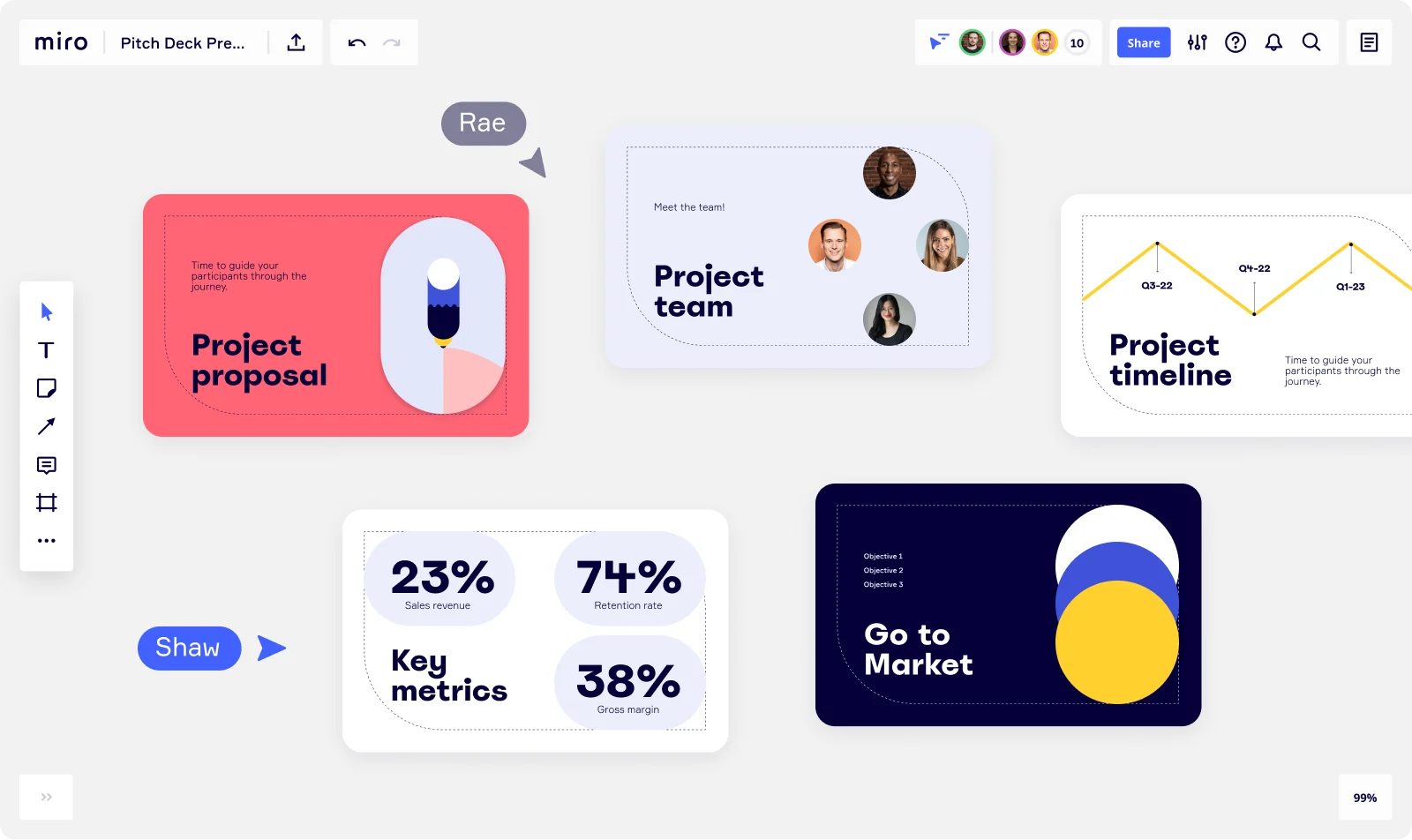
Table of contents
Table of contents
What is a pitch deck?

Summary
In this guide, you will learn:
- What a pitch deck is and its purpose
- Typical components of a pitch deck
- How to structure and design a pitch deck
- Tips for tailoring and refining your pitch deck
- How to use Miro’s pitch deck templates and tools
- Best practices for presenting your pitch deck interactively
Try Miro now
Join thousands of teams using Miro to do their best work yet.
What is a pitch deck? A quick guide
As a knowledge worker, you might grapple with a common question: what is a pitch deck? Fear not, because we're here to dissect this crucial tool and guide you through the process of creating one that can take your business to the next level.
What is a pitch deck: The basics
A pitch deck, often considered the cornerstone of entrepreneur and investor communication, is a brief and visually compelling way to create a presentation that overviews your business. This invaluable tool provides a snapshot of your company's value proposition, market analysis, product details, and more. It's your golden ticket to securing the interest and backing of potential investors.
Understanding how a pitch deck works
Think of your pitch deck as your company's story condensed into a powerful narrative, the quintessence of your venture told through compelling visuals and concise text. This tool communicates the "what" and the "why" behind your business. It conveys your mission, vision, and strategy in an easily digestible format, ideally leaving investors intrigued and keen to know more.
What are the components of a typical pitch deck?
An effective pitch deck typically consists of the following elements:
- Introduction: The essence of your company—what it is and what it does.
- Team: Details about the skilled people driving your venture.
- Problem: The issue your product or service aims to address.
- Solution: Your unique value proposition.
- Market analysis: Your target audience and market size.
- Product: In-depth details about your product or service.
- Business model: How you intend to make money.
- Marketing and sales strategy: Your plan to attract and retain customers.
- Financials: Current performance and future projections.
- Ask: Your request from investors, whether it's funding, advice, or partnerships.
Advantages of making a pitch deck
A well-constructed pitch deck offers multiple benefits:
- Clarity: By distilling your business into a pitch deck, you understand your venture more clearly, helping you articulate your vision effectively.
- Investor attraction: An engaging pitch deck is a magnet for investors. It communicates critical details about your business and demonstrates your professionalism and commitment.
- Guidance: A pitch deck provides a roadmap for investor presentations, guiding the flow of conversation and ensuring key points are addressed.
3 Successful SaaS companies with great pitch decks
- Airbnb: Airbnb's original pitch deck succinctly outlined its unique value proposition, market analysis, and growth strategy. It effectively showcased their novel solution to a widespread problem, capturing investor interest.
- Slack: Slack's pitch deck focused heavily on their product, using powerful visuals and simple explanations to communicate their platform's benefits. They underscored their unique selling points, clearly differentiating themselves from competitors.
- Zendesk: Zendesk's pitch deck is a testament to the power of storytelling. They successfully used a narrative approach to guide potential investors through their customer service solution, making their proposition highly relatable.
How to make a pitch deck
Creating a compelling pitch deck involves thoughtful design, clear writing, and strategic storytelling. Here are some steps to guide you:
- Understand your audience: Understand your potential investors' interests and concerns to tailor your pitch deck effectively.
- Define your structure: Outline your deck using the key components mentioned earlier. This will serve as your pitch deck template.
- Create your content: Keep your text succinct and impactful. Use data to support your statements and weave a compelling story around your business.
- Design your slides: Use a clean, professional design. Leverage visuals and infographics to communicate complex information.
- Refine and practice: Revise your deck, seek feedback, and practice your delivery. Remember, your pitch deck is not just a document—it's a presentation.
Tips and best practices when making a pitch deck
- Less is more: Avoid cluttering your slides with text. Stick to key points and let your oral presentation fill in the details.
- Consistency is key: Maintain a consistent design throughout your deck. This includes colors, fonts, visuals, and tone of voice.
- Data-driven: Back your claims with relevant data. This demonstrates market understanding and adds credibility to your statements.
- Tell a story: People connect with stories. Weave a narrative around your business journey, from the problem you're solving to the solution you're offering and your vision for the future.
- Call to action: Make sure to include a clear 'ask'. Whether you're seeking funding, partnerships, or advice, be specific about what you want from your audience.
Creating a pitch deck might initially seem daunting, but with the right approach and tools, you can craft a compelling presentation that captures your audience's attention and leaves a lasting impression. Remember, your pitch deck reflects your business vision—it should not just inform but also inspire. Happy crafting!
Author: Miro Team
Last update: October 14, 2025